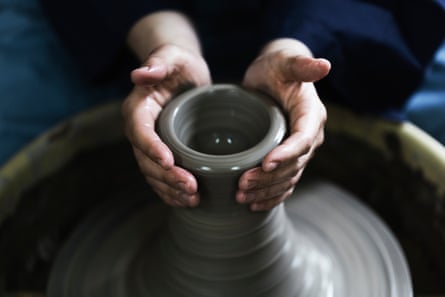Meditation isn’t for everyone. Or at least not when life has taken you so far from calm that your brain is soup. “It’s the nature of the mind to have this ongoing conversation in the background,” says Joy Rains, a mindfulness practitioner and author of Meditation Illuminated: Simple Ways to Manage Your Busy Mind. “I call this ‘Stuff’, which is an acronym for stories, thoughts, urges, frustrations and feelings. When you’re in a meditative state, you’re in the here and now and you’re releasing your Stuff. You’re not getting caught up in judgments, thoughts about the past, worries about the future.”
There is a growing body of evidence that “releasing our Stuff” like this is an effective antidote to 21st-century life, helping us to concentrate, remember things and become more self-aware, while reducing anxiety, depression and stress. The good news is that we don’t have to be brilliant at sitting still and focusing on our breath to get meditation’s recuperating benefits, says psychologist Suzy Reading. Despite also being a yoga teacher, Reading admits to having struggled with traditional meditation practices, “and they are inaccessible for a lot of people. But that’s not to say that meditation is not for them.”
Rains agrees that you can get as much out of bringing mindfulness to a range of activities as you can from traditional seated meditation. “The whole idea with mindfulness is training your brain,” she says. “You can do this just as well by being intentionally mindful throughout the day. I don’t think there’s a right or wrong way, and it’s important to do practices that resonate with you.”
Walking
Rains recommends that people practise mindfulness when they walk, partly “because when we’re walking, we’re not doing much else other than maybe being caught up in our stuff. That’s a great time to bring awareness, instead, to your feet as they connect with the ground.” This is where self-awareness boosting comes in, because when you notice that your mind has wandered, you can look at what has popped into your head before gently returning your attention to your feet. Wearing thin-soled or “barefoot” shoes can make the feeling of your feet touching the ground even more engaging.
For dog owners, Rains suggests, “notice the dog’s tail wagging, the sound of the dog’s feet clicking on the pavement, the clouds of breath coming out of your dog’s mouth on a cold day”. It is hard not to, which is arguably one of the benefits of pet ownership.
Being awed by nature
Encountering awe is an established element of mindfulness practice. “There is a lot of research around awe,” says Reading, “and we can experience its blissful sense of transcendent connection in as little as 15 seconds. That’s an incredible mood booster. You don’t have to be in a national park to experience that – just look up at the trees and sky, watch the sunrise.”
Many a birdwatcher or angler will tell you that being in nature for hours on end is what their hobby is truly about. When we’re in nature, says Reading, “we engage in a panoramic gaze, which is really different to when you’re on a Zoom call, or focusing on a screen. The panoramic gaze allows peripheral vision in, and it’s soothing for your nervous system.”
Awe can be summoned by other things, too, such as looking at art or watching a great performance. “These things can anchor us in a sense of being part of something bigger than ourselves.”
Drawing
A friend has discovered that the sense of flow she feels in her weekly life-drawing class does more for her than improving her shading skills. “This is when you are so engaged in what you’re doing that stuff doesn’t keep distracting you,” says Rains. “You can really flow in the moment … and your attention is here and now – that’s why this kind of activity can be relaxing and restorative.”

Housework
“Folding the washing can be a form of meditation,” says Reading. Don’t rush it, inhale the fresh laundry scent, notice the textures of the fabrics, apply yourself to working satisfyingly neatly, pretend you’re in an ASMR video, if it helps. You’ll be doing mindfulness training, relaxing a little and it will probably take you no longer than if you were rushing (more haste, less speed). If this makes you think “What, people fold their laundry?”, then apply mindfulness to vacuuming or cooking instead, says Reading. “Or how you eat your food. You can turn just about any activity into a meditative pursuit by really listening to your senses.”
Trying new things
Reading, whose new book is called Rest to Reset, is adamant that both meditation and rest can be “movement, it can be connection, it can be something that is a little bit mentally stretchy. Maybe cooking a new dish or learning a new creative skill can be the thing that really helps you feel alive.”
Rains says that doing something that taps into our curiosity, as opposed to something that is really comfortable and familiar, “whether it is a creative pursuit or any kind of skill, is going to enlighten us, because it is using our brain in a different way. I think that will surprise people, because most people would associate meditation and rest with switching off.”
Staring out of the window
“We need to do a bit of myth-busting around meditation,” says Reading. “Most people who come to me wanting to build a meditation practice associate it with clearing the mind. As a psychologist, I have a lot of people saying to me: ‘I want to get rid of this thought, I don’t want to have this feeling.’” But trying to clear the mind only makes it even louder. Focusing on objects can help us to step out of the busy mind-traffic, so that we can notice and accept it, rather than try to eliminate it. This could mean taking five minutes to admire a candle flame, or gaze out of a window. “Sit on a park bench and watch the world go by,” suggests Reading. “Look for interactions of kindness between people.”

“There is no such thing as bad meditation,” says Rains. “If you’ve noticed that your mind has gone elsewhere, that’s all part of it.” Every time you notice and focus anew on the street scene or flickering flame, “you’re becoming skilled at directing your mind”.
Writing
There may be times we need to take a break from our thoughts and feelings, says Reading, but there are also times we need to bear witness to them. “Meditation can be reflective writing, sitting with our feelings.” Speaking partly from personal experience, Rains says: “Often when people write, they will be judgmental and their thoughts interfere with their voice.” So the goal here is, she says, “to set all judgments aside and write what’s true in the here and now, without getting distracted by other tasks that need to be done”. Scheduling a dedicated time slot helps.
Working
Practising mindfulness doesn’t have to be a relaxing thing, says Rains, who works with individuals as well as organisations such as the US Food and Drug Administration. While doing it in a relaxing way may be more pleasurable, “focusing on the non-pleasurable can help you to reduce stress, too”. That dreaded situation when your boss summons you to their office out of the blue can provide a fine opportunity to practise mindfulness. If you start panicking that you’re for the chop, says Rains, “bring your attention to the present and notice that you’re telling yourself a story about something that hasn’t happened. Ask yourself: ‘Can I stay with not knowing what’s next? Can I notice the tension in my body? Can I release those muscles?’”

Singing in a choir
The diverting flow of singing with others cannot be denied, but that’s not the only meditative opportunity. “My mother is 95 and sings in the choir in her senior living home,” says Rains. “For her sometimes it’s stressful to learn a new song because she feels insecure about remembering things.” If you’re in a challenging moment, noticing what’s going on in your mind is step one. Step two is, she says, “can you let go of that mind-talk and stay with the experience, focusing on what it’s like to be in this community, to feel my voice box vibrating and hear sound coming out of my mouth? Are my feet planted firmly on the ground? Do I feel balanced? Can I feel my chest rising and falling as I sing?”
Build something
Lego is the new colouring-in for grownups. John Lewis has reported that sets for adults, such as posies of flowers, are having a sales boost, while a friend of mine was thrilled this week to receive a Lego set of the TV show Friends for her 49th birthday. Rains can see why. “Feel the bumpy bricks, look at the colours, listen to them clunking together,” she says. “Maybe you have a vision of how it’s going to be when it’s finished – so I’m saying something a little different here, because you’re taking your mind to the future. But you’re looking at the whole of the project, and seeing what you’re doing as a piece of a larger picture. I would consider that being mindful.”
Going to the movies
You could argue that this is too passive an endeavour, sitting back and being manipulated. But while captivated, you might well get a break from your mind, and opportunities to build self-awareness and learn to redirect your thoughts can arise. You might start jumping to conclusions about what will happen next, which, says Rains, “takes you out of the present and away from watching the story unfold as it was written. Instead, stay with the story and the unknown of what’s going to happen next.”

Pottery
“What a great way to stay present,” says Rains. “There are so many different sensory experiences while learning to set judgments aside – this bowl is crooked, or this person isn’t going to like this thing I made for them, or I’m having trouble with the wheel and I’m getting frustrated. Notice what these judgments feel like in your body, the texture and temperature of the clay, the sound of the wheel, and you will shift from the brain whirring to the potter’s wheel whirring.”
